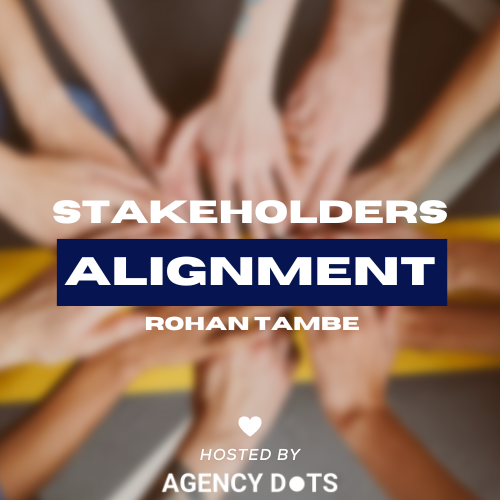Align stakeholders to deliver a project successfully
Rohan Tambe is an experienced project manager who worked in different industries. In this interview, we will talk about how to align stakeholders to deliver a project successfully.
Stakeholders alignment is key to keep every project on track

Tell us about your PM background.
I’ve worked as a project manager in several industries for more than ten years. I progressively transitioned from sales to operations and finally project management. I’ve managed projects across various domains from Utility engineering, FMCG, Agritech, E-commerce, and IT service, each with its own special difficulties, technical challenges, and learning opportunities.
Currently, I’m working in an IT service company, where my core KPI is delivering e-commerce websites for various B2B and B2C brands. In this role, I work and manage cross-functional teams and ensure projects are completed on time and within budget while meeting clients’ expectations
What I enjoy most about project management is the continuous learning. Each project brings something new, whether it’s different requirements, different use cases, different people and processes. I’m usually curious and always looking for ways to improve processes and increase productivity.
How do you ensure all stakeholders are aligned in a project?
It is very crucial to have alignment among stakeholders in any project.
Personally, I start by identifying all stakeholders early in the project to understand their interests, expectations, and concerns. This involves detailed discussions to outline their roles and responsibilities clearly. I use the RACI charts (meaning identifying who is Responsible, Accountable, Consulted, and Informed) to help me align all stakeholders. This brings a lot of clarity even to the stakeholders as to who they should discuss with if any conflicts/issues occur during the project.
I also communicate regularly, set clear objectives, and build relationships with stakeholders.
What are some challenges you face in aligning stakeholders?
The major challenges are well-known among all project managers for example aligning all stakeholders, communication, and handling change resistance.
Let’s talk about each of these separately. Firstly, stakeholder alignment. Although it seems very obvious that all stakeholders must be aligned for the project to be successful; it often happens that stakeholders change priorities, expectations, or even the entire project objective.
Secondly, clear communication. When running a project with people from different cultural backgrounds, technical know-how, having frequent communication and feedback sessions is crucial. Avoiding this leads to miscommunication and false interpretation of information. Often people fail to communicate expecting that everyone is aligned. I’ve learned the hard way that over-communication is better than no communication.
Finally, resistance to change is another common challenge I’ve faced. It’s important to note that projects are implemented to initiate a change. I’ve noticed that sometimes people resist change by trying to implement the past processes or features within the project. Therefore it’s important that project managers keep everyone informed and educated throughout the project about the necessities for which the project was initiated.
Share with us a practical example of when aligning stakeholders was challenging
The main challenge in aligning people is that they are humans and not machines, fortunately. Each one is unique and has different priorities.
My team and I had a client who wanted a website built and also improved their marketing activities. The stakeholders in this project included our internal team of developers and marketers, the client’s marketing and operations team, and project sponsors.
The main objective of the project was to build an improved e-commerce website ASAP. During the project planning phase and development, the project sponsors were responsible for providing decisions and approvals. However, when the client’s marketing and operations team saw the website they wanted to make significant changes. Implementing these changes would require almost a redevelopment of the entire project. Now the rubber met the road, resolving this issue was my responsibility since the project was about to go live.
To resolve this both the client teams ie the project sponsors and the marketing/operations team had to get on the same page. We held joint meetings, set new timelines, approved a new budget, and defined a new project objective. Moving forward we made sure the right people approved each step of the project and assigned this responsibility to the client’s team.
Who are the different stakeholders you work with on a project?
Let’s take an example of a brand that wants to launch an e-commerce website to increase its profitability. In this case, we have stakeholders like the marketing team, the IT department, the operations team, the project sponsors, and vendors.
The main challenge is each team has its objectives, which are a reflection of the team’s function within the company. Here is an example of how a team’s interest can be split.
- The marketing team would want a website that is visually stunning and attracts more customers, they want it to be content-heavy to provide as much product information as possible.
- The IT team on the other hand would like to keep the website lite with very little data as it will reduce the infrastructure cost and the load time.
- The operations team is focused on the reporting and usability of the website and would like to implement all such features which will help them reduce the operations time. Technically this will call for additional efforts and ultimately increase the cost of the project
- Vendors on the other hand would like to stick to the scope of work, complete the website at the earliest, and start billing the customer.
- Project sponsors who invest in the project would like to launch the project at the earliest and start generating revenue from the website.
It’s clear that every stakeholder has a different interest in the project. The role of the Project Manager is to align everyone, negotiate where necessary, and most importantly remind everyone of the objective. In this case, it is to launch a website that is user-friendly and generates revenue within a given timeline and budget.
What’s the most important lesson you’ve learned as a project manager?
Being adaptable is important for every project manager. There is a lot of planning that goes behind executing a project. But my experience has taught me that projects rarely go according to plan. Therefore, it’s of no use complaining when things do not go as planned. Adapt and you’re more likely to succeed!
Communication is another key skill for project managers as I’ve mentioned previously. To keep all stakeholders on the same page requires effective communication.
Lastly, listening. This means actively listening to the concerns, feedback, and valuable insights that your team puts forth and also implementing the ones that add value to the project. While doing this, recognizing the team member is equally important as this builds trust, and ensures that everyone feels heard and valued which ultimately gives you a team that is loyal and objective-focused.
Try AgencyDots for free!
Control your entire project portfolio from one place.
Make your software development agency efficient.
No credit card required.

